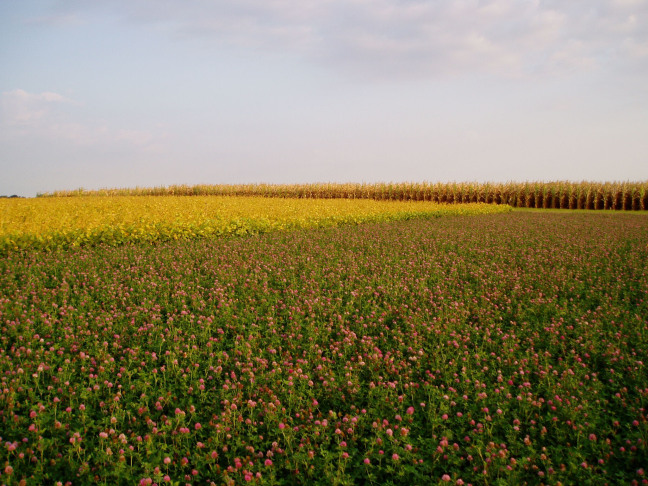Ames, Iowa, USA
November 10, 2020

Red clover is grown in rotation with corn and soybean. The clover competes with weeds growing in oat stubble and adds nitrogen for the succeeding corn crop. Such crop diversification practices can lead to better ecosystem outcomes without sacrificing yields, according to a new study. Photo by Paula R. Westerman.
A new study shows diversifying agricultural systems beyond a narrow selection of crops leads to a range of ecosystem improvements while also maintaining or improving yields. But a professor of agronomy at Iowa State University who co-authored the study said some marketing and agricultural policy considerations will have to change for farmers to adopt diversification practices more widely.
The study, published last week in the academic journal Science Advances, analyzed the results of 5,188 separate studies that included 41,946 comparisons between diversified and simplified agricultural practices. An international team of researchers carried out the study, known as a meta-analysis, and looked for patterns in the mountains of data collected in previous field studies. The results showed that in 63% of the cases examined, diversification enhanced ecosystem services while also maintaining or even improving crop yields. The researchers described this as a "win-win" result.
“The overall conclusion is there’s a lot to be gained from diversifying cropping practices,” said Matt Liebman, a professor of agronomy at Iowa State and co-author. “Across many different countries in many different climates and soils, with many different crops, the general pattern is that with diversification, you maintain or increase crop yields while gaining environmental benefits.”
Agriculture in the Midwest is dominated by just a few crops, mainly corn and soybeans. But the study looked at a range of farming practices aimed at introducing more diversity to cropland. Those diversification practices include crop rotations, planting prairie strips within and along fields, establishing wildlife habitat near fields, reducing tillage and enriching soil with organic matter. Such measures improve water quality, pollination, pest regulation by natural enemies, nutrient turnover and reduced negative climate impacts by sequestering carbon in the soil.
“My colleagues and I wanted to test if diversification is beneficial for both agricultural production and ecosystem services. The current trend is that we simplify major cropping systems worldwide. We grow monocultures on enlarged fields in homogenized landscapes. The results of our study indicate that diversification can reverse the negative impacts that we observe in simplified forms of cropping on the environment and on production itself,” said lead author Giovanni Tamburini at the Swedish University of Agricultural Sciences and University of Bari.
Changes in policy needed
Liebman said barriers related to government ag policy, market considerations and the dissemination of data discourage farmers from adopting many of the diversification practices examined in the study. But showing that such practices do not depress yields, and in some cases increase them, might encourage farmers to consider the practices.
Many current policies and market conditions incentivize farmers to focus on a few highly productive and profitable crops. In Iowa, that means corn and soybeans are grown on the majority of cropland. But Liebman said rethinking those considerations, as well as working with farmers to transfer knowledge that allows them to gain confidence with diversification, could lead to wider use of the practices.
The meta-analysis approach allowed the research team to combine data from thousands of other studies that tested how crop diversification affects yields. The researchers used innovative data analytics to find patterns in those results, Liebman said. The approach allowed the research team to gain a new level of insight that isn’t possible with individual experiments.
“What our study suggests is that if we want improved water quality and enhanced wildlife habitat and if we want to continue to work on the soil erosion problem, diversification offers a lot of options to us,” Liebman said.